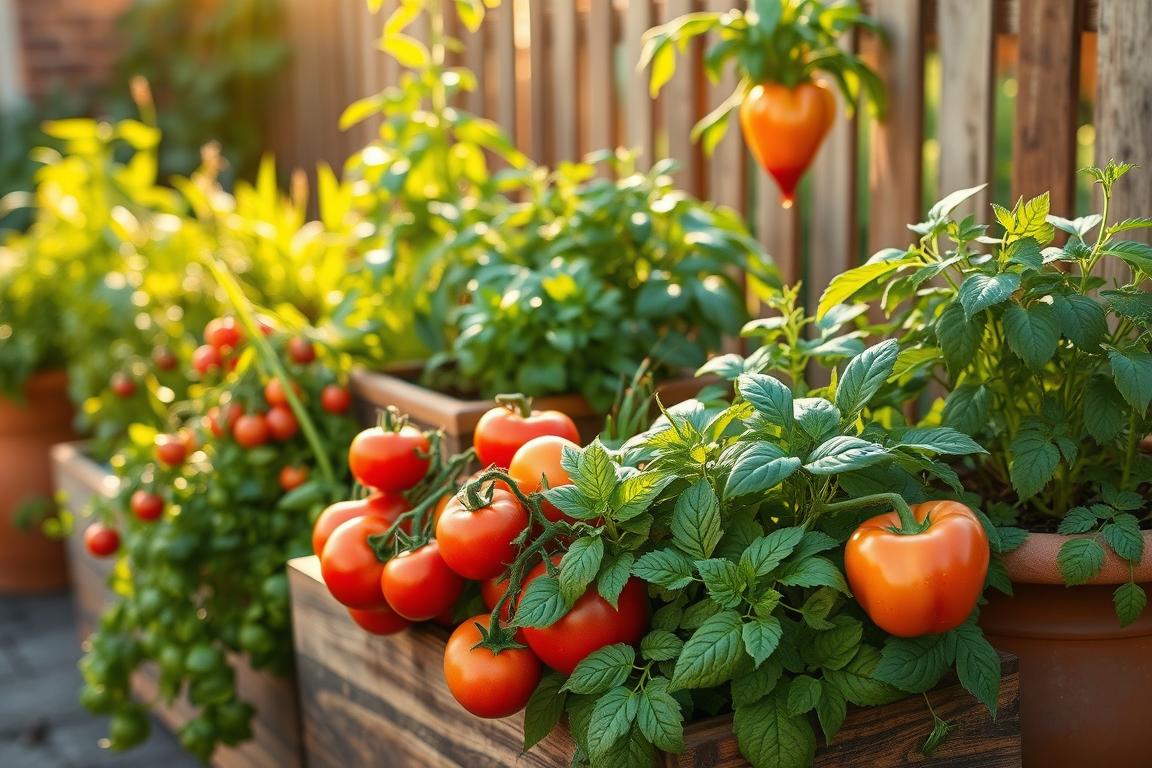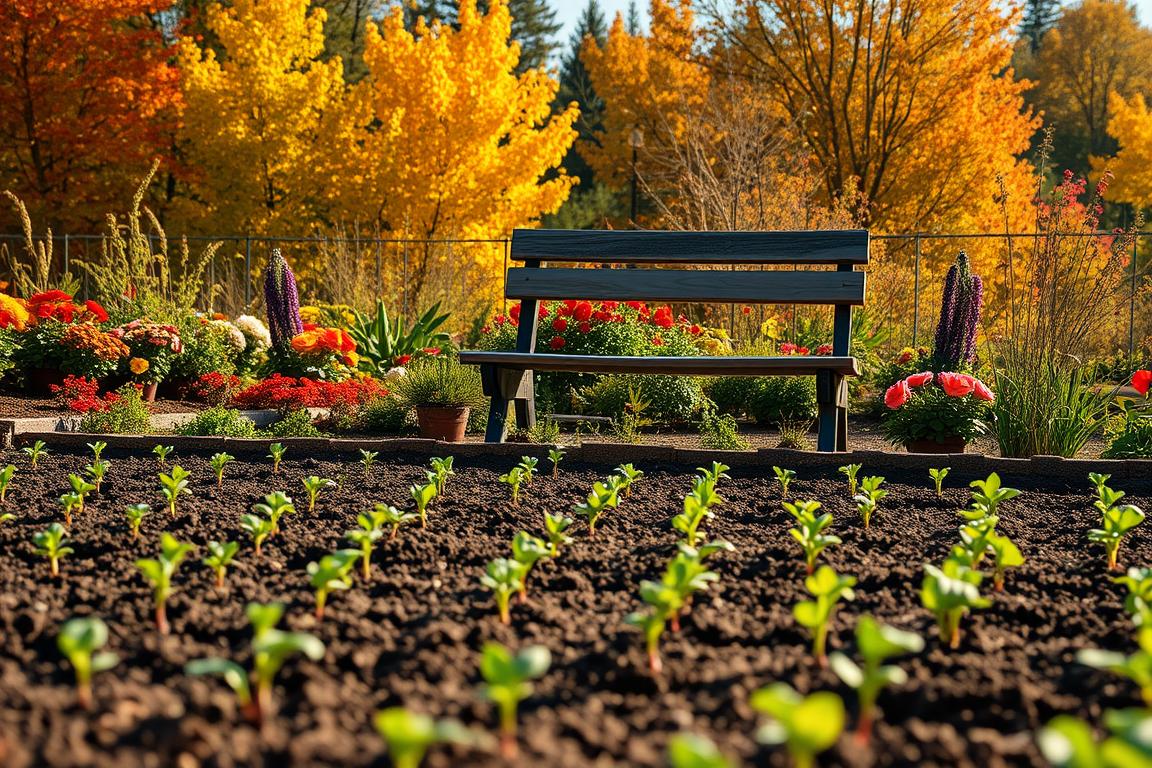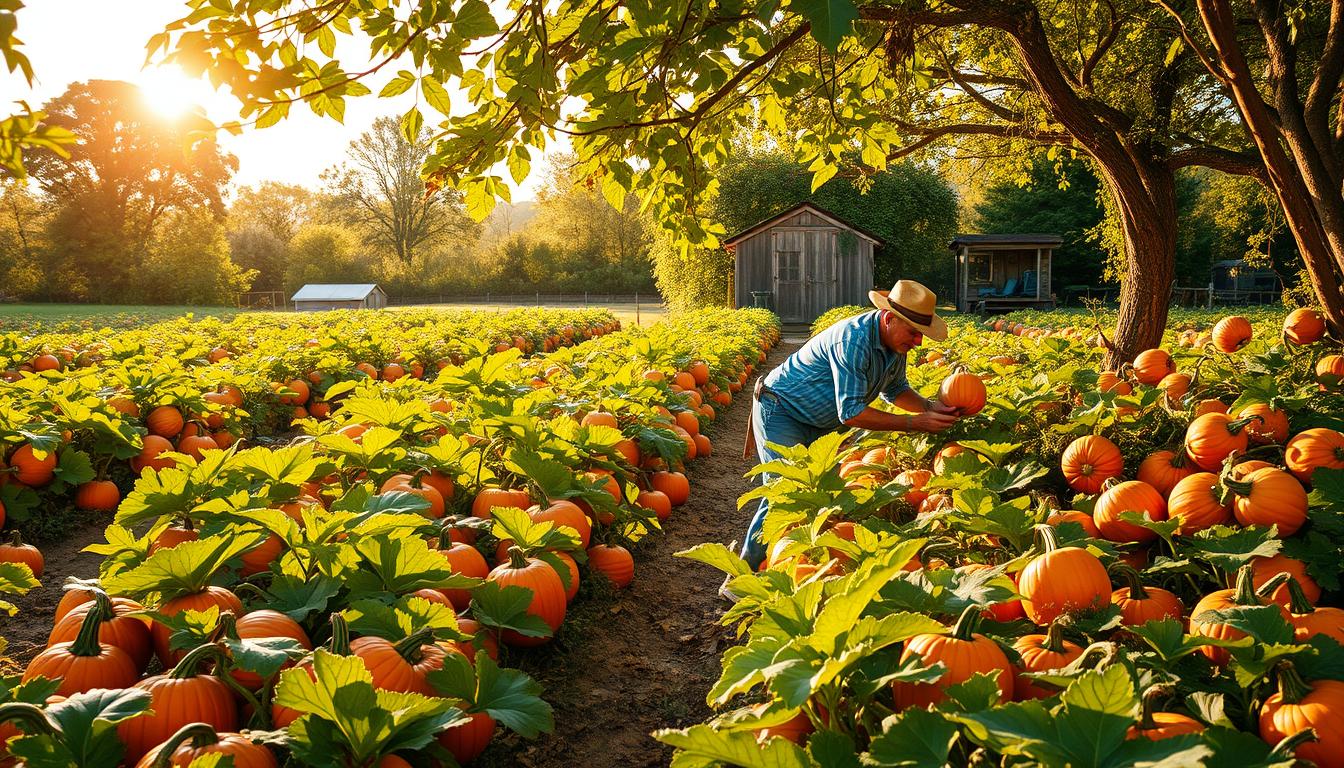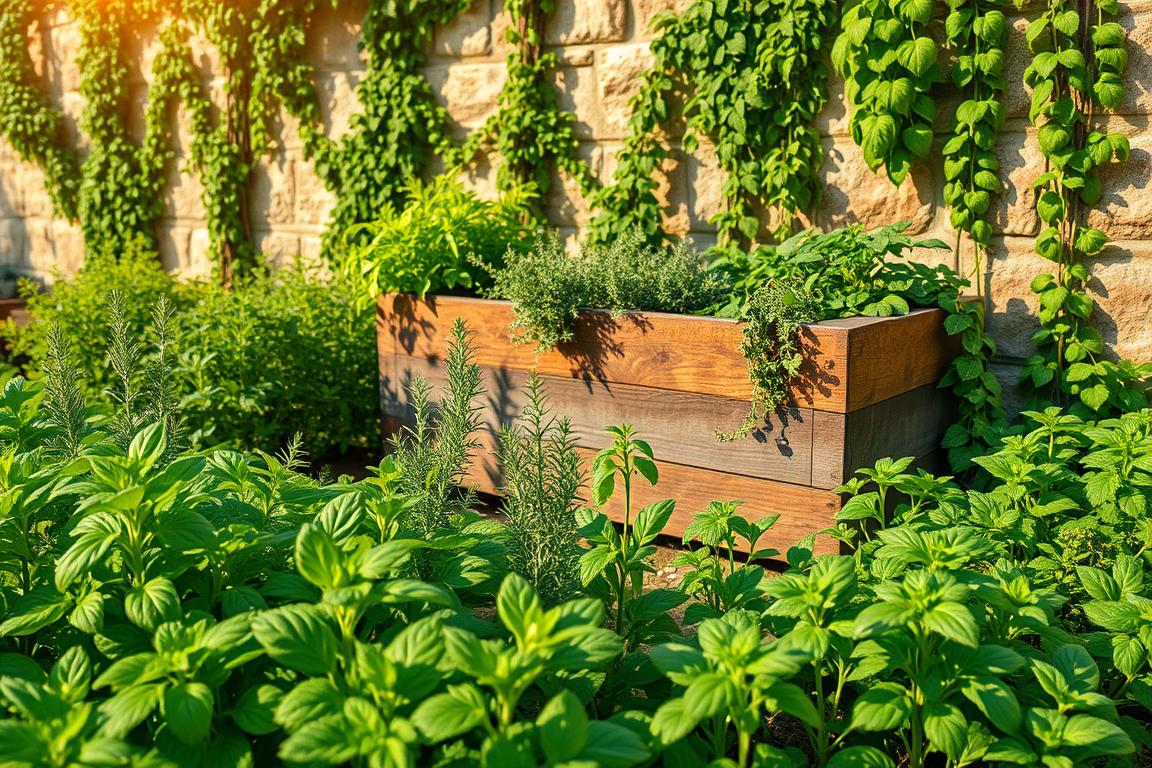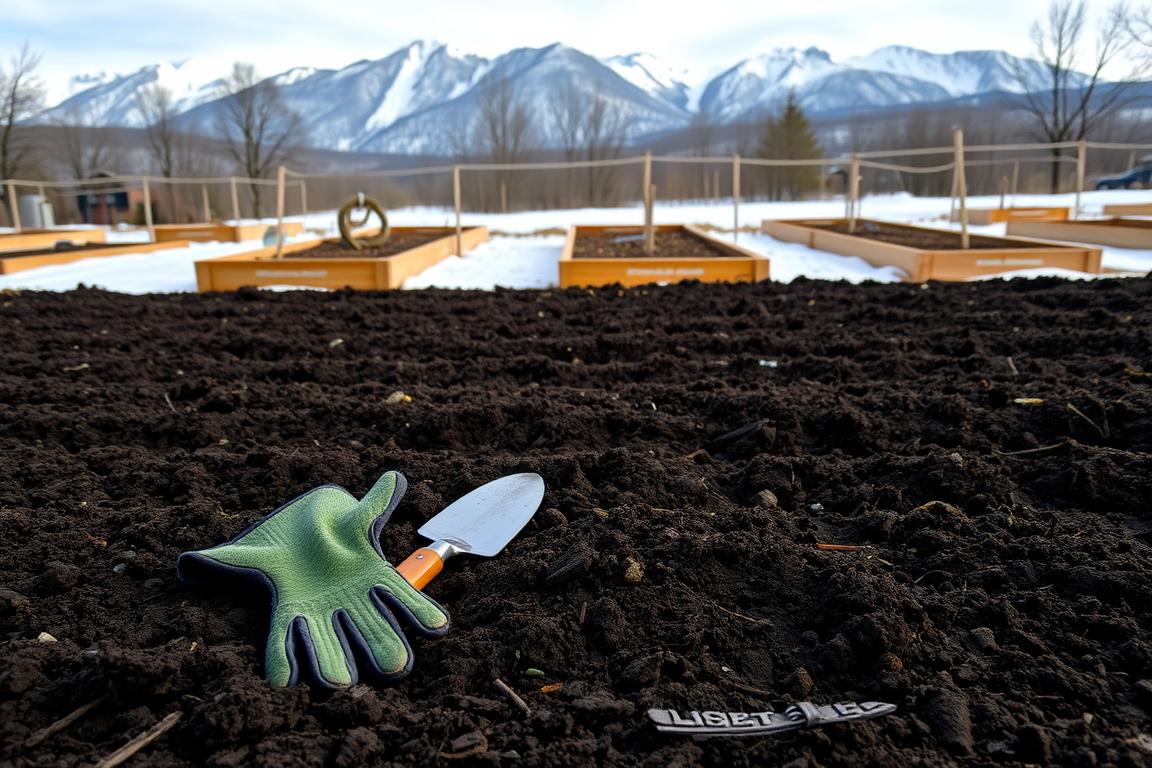I’ve found that container gardening is a great way to get fresh veggies, even with little space. The Spruce says it’s perfect for urban gardening and small space gardening. It lets you grow many veggies in containers, great for apartment dwellers or those with tiny yards.
With container gardening, you can get around the usual gardening limits. It’s not just about saving room. It also means you can control the soil and temperature, helping your plants stay healthy.
Key Takeaways
- Container gardening is ideal for small spaces.
- It allows for better control over soil quality.
- You can grow a variety of vegetables.
- It’s perfect for urban and small space gardening.
- Container gardening can lead to healthier plants.
The Joy and Practicality of Container Vegetable Gardening
Container vegetable gardening is a mix of joy and practicality. It’s not just about growing veggies. It’s about making a green space in unexpected places. You can turn a small balcony, patio, or sunny windowsill into a garden.
Benefits for Urban and Small-Space Gardeners
Container gardening is great for city and small-space gardeners. It gives you flexibility and control over your garden. Here are some benefits:
- You can relocate plants to optimize sunlight and temperature conditions.
- It’s ideal for small spaces, such as balconies, patios, or rooftops.
- It helps prevent soil erosion and improves soil quality.
Year-Round Growing Possibilities
Container gardening allows you to grow vegetables all year round. By relocating containers or utilizing cold frames and greenhouses, you can continue to grow in winter. This means you can have fresh produce even in cold weather or short seasons.
Choosing the Perfect Containers for Your Vegetables
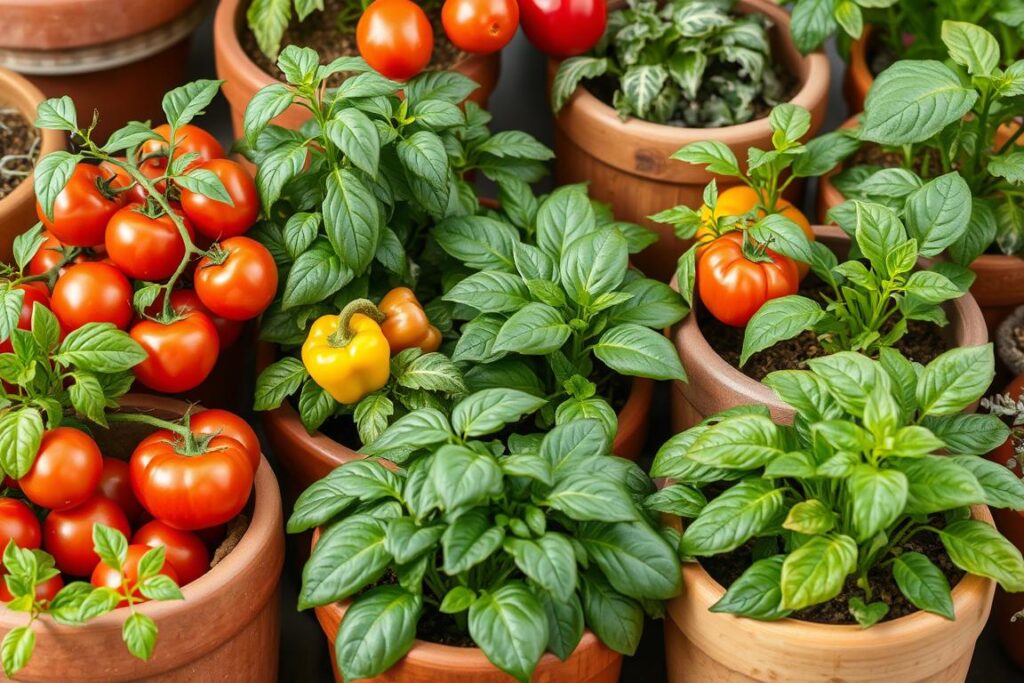
Starting a container vegetable garden is an exciting endeavor. The first step is picking the right pot. The right container is key to a successful garden.
Container Materials: Plastic, Terracotta, Fabric, and More
Containers are made from many materials, each with its benefits. Plastic containers are light and easy to clean. Terracotta pots give a natural look. Fabric containers, also known as grow bags, are flexible and allow air to circulate.
When selecting a material, consider its durability, warmth retention, and moisture-wicking capabilities.
Size and Depth Requirements for Different Vegetables
Vegetables need different sizes and depths. Leafy greens do well in shallow pots. But tomatoes and peppers need deeper roots for their roots.
Choose a pot that’s at least 6-8 inches deep for most veggies.
Essential Drainage Solutions
Good drainage stops waterlogged soil and root rot. Look for pots with holes or drill your own. A layer of small rocks or broken pottery helps, too.
Drainage keeps your plants healthy and productive.
Creating the Ideal Soil Environment
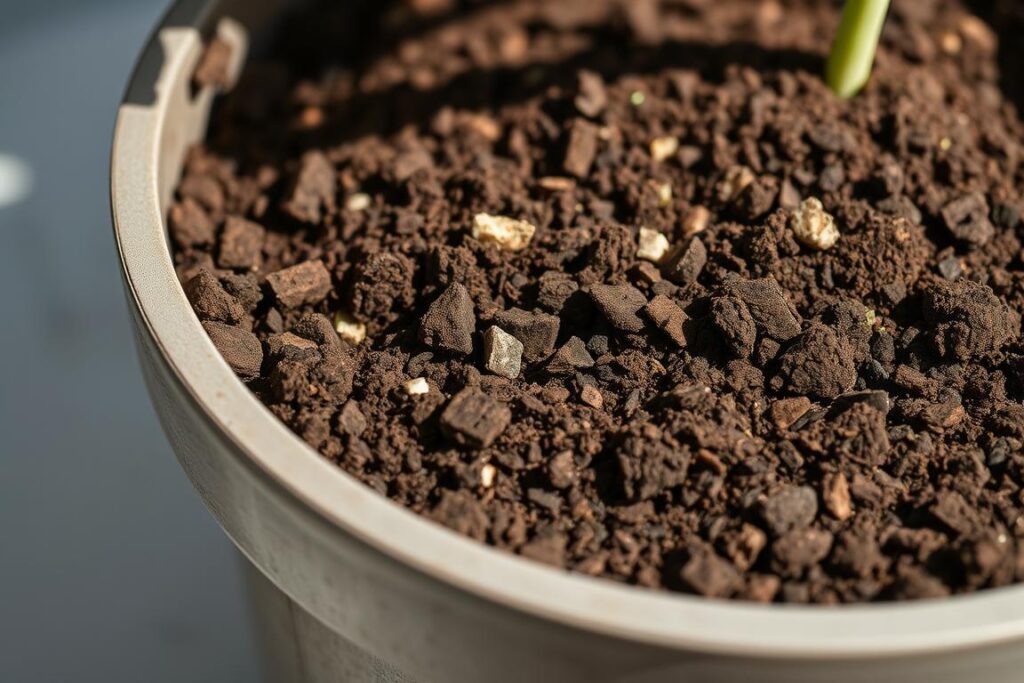
To grow veggies in containers, you need the right soil. It should help roots grow and take in nutrients. Container gardens require a specialized soil mix, distinct from regular garden soil.
Why Regular Garden Soil Won't Work
Regular garden soil is too heavy for containers. It can cause water to pool, leading to root rot. Container gardens need a mix that drains well and holds moisture without getting too wet.
My Favorite DIY Container Soil Recipes
A great container soil mix includes potting soil, compost, and perlite. Here’s a recipe I like: Mix 50% potting soil, 20% compost, 10% perlite, and 20% peat moss or coconut coir. This mix drains well, is airy, and rich in nutrients for my veggies.
Maintaining Soil Health Throughout the Season
To keep soil healthy, monitor the moisture level and avoid excessive watering. Add compost on top every few weeks for nutrients. Additionally, check the soil’s pH level and adjust it as necessary for optimal plant growth.
| Soil Component | Function | Recommended Percentage |
|---|---|---|
| Potting Soil | Base soil | 50% |
| Compost | Provides nutrients | 20% |
| Perlite | Improves drainage | 10% |
| Peat Moss or Coconut Coir | Retains moisture | 20% |
Best Vegetables for Growing in Containers
Choosing the right vegetables is key for a thriving container garden. Even in small spaces, you can enjoy a rich harvest. It’s all about picking the right plants.
Compact Varieties Perfect for Pots
For container gardening, go for compact or dwarf varieties. Think compact tomatoes, peppers, and leafy greens, such as lettuce and kale. These plants are small but pack a punch, yielding a lot of produce without occupying much space.
Shallow-Rooted Vegetables for Small Containers
Vegetables with shallow roots do well in small containers. Radishes, spinach, and green onions are great examples. They can grow well in just 6-8 inches of soil.
Deep-Rooted Vegetables That Need More Space
Carrots and beets require more space due to their extensive root systems. Make sure your containers are at least 12 inches deep. This gives them the space they need to grow.
Special Considerations for Tomatoes and Peppers
Tomatoes and peppers are favorites for container gardens. For tomatoes, choose containers that are at least 18 inches deep. They’ll also need support as they grow. Peppers thrive in larger containers with excellent drainage.
Companion Planting in Containers
Companion planting enhances the health and yield of your container garden. For instance, marigolds can keep nematodes away from tomatoes. Here’s a simple guide to help you plan:
| Main Crop | Companion Plant | Benefit |
|---|---|---|
| Tomatoes | Marigolds | Nematode deterrent |
| Peppers | Basil | Improved flavor |
| Leafy Greens | Radishes | Pest control |
By picking the right vegetables and companions, your container garden can thrive. Even in the smallest spaces, you can have a diverse and productive garden.
Essential Care Techniques for Growing Vegetables in Containers
To keep your container vegetable garden thriving, mastering a few essential care techniques is crucial. Proper care ensures healthy plant growth and maximizes your harvest.
Watering Secrets: Timing and Techniques
Watering is a critical aspect of container care. Vegetables in containers dry out more quickly than those grown in the ground. So, consistent watering is key. Check the soil moisture by inserting your finger into the soil up to the first knuckle; if it’s dry, it’s time to water. Water thoroughly until you see water draining out of the container’s bottom holes.
Some effective watering techniques include using a watering can or a soaker hose, which deliver water directly to the roots, thereby reducing evaporation and runoff.
Fertilizing Strategies for Container Plants
Fertilizing is vital for container gardens because the soil volume is limited. Use a balanced, water-soluble fertilizer to provide essential nutrients. You can also mix in compost or well-rotted manure to improve soil fertility and structure.
- Apply fertilizer according to the manufacturer’s instructions.
- Consider using a slow-release fertilizer for consistent nutrient supply.
Maximizing Sunlight and Managing Temperature
Most vegetables require at least 6 hours of direct sunlight per day. Position your containers to maximize sunlight exposure. To manage temperature, use light-colored containers to reflect heat. Avoid placing containers near heating vents or drafty areas.
Pruning and Support Systems
Pruning and support are crucial for healthy plant growth and maximizing yields. Prune your plants to encourage bushy growth and prevent disease. Use tomato cages, trellises, or stakes to support plants that need it, such as tomatoes and peas.
Troubleshooting and Preventing Common Container Garden Problems
When I care for my container garden, I find that solving problems is crucial for a good harvest. Container gardens often face issues such as pests, diseases, and weather stress. These can be tough to handle.
Natural Pest Management Solutions
Using natural methods is a smart way to fight pests. Neem oil is a potent insecticide that effectively controls aphids and whiteflies. Pairing plants to keep pests away is also effective.
“Companion planting is a great way to reduce pest problems without using chemical pesticides,” a gardening expert notes. Adding beneficial insects, such as ladybugs and lacewings, can also help control pests.
Identifying and Treating Plant Diseases
Plant diseases can be a big problem in container gardens. Look for signs such as yellow leaves, black spots, or powdery mildew to identify diseases. Once you find the disease, you can start treating it.
Removing infected parts can prevent the disease from spreading. Fungicides can be used to treat fungal diseases. Keeping tools and containers clean is crucial in stopping the spread of disease.
Overcoming Weather Challenges
Weather can be particularly tough on container gardens, with extreme temperatures and heavy rainfall. To combat these issues, you can use shade for plants in the sun or row covers to protect against frost. Containers with good drainage help prevent water from accumulating.
Being ready and taking steps ahead can lessen the weather’s impact on your garden.
Conclusion: Harvesting Success from Your Container Garden
Growing veggies in containers is rewarding, even in small spaces. Choose the right containers and soil. Select the best vegetables for your garden to ensure success.
We’ve covered important care tips, like watering and fertilizing. We also discussed increasing sunlight exposure and addressing common issues. These tips will help you grow a successful harvest.
Starting your container garden? Remember, planning and care are crucial. With the right knowledge, you’ll enjoy fresh veggies all season. Follow the advice in this article to harvest your own veggies soon and experience the joy of gardening success.
FAQ
Q: What are the benefits of growing vegetables in containers?
A: Growing veggies in containers has many perks. It allows you to garden in tight spots and control the soil more effectively. It also reduces disease risks. Additionally, you can relocate plants to receive more sunlight and the ideal temperature.
Q: What type of containers are best for growing vegetables?
A: Choose containers that drain well and are sturdy. They should fit the veggies you’re growing. Options include plastic, terracotta, and fabric. Wooden or metal planters work too.
Q: How often should I water my container vegetables?
A: Container veggies need more water than ground-grown ones. Soil dries out fast. Check by sticking your finger in the soil. Water when the top inch feels dry.
Q: What is the best soil for container gardening?
A: Use a potting mix made for containers. Don’t use regular garden soil. It can pack down and block water. You can make your own mix with peat moss, vermiculite, and perlite.
Q: Can I grow any type of vegetable in a container?
A: Many veggies can grow in containers, but some are better. Look for compact or dwarf varieties, such as tomatoes and cucumbers. Leafy greens, herbs, and carrots also do well.
Q: How can I prevent pests and diseases in my container garden?
A: To keep pests and diseases away, check your plants often. Use barriers to stop pests. Treat fungal diseases with organic fungicides. Keep containers clean and avoid too much water.
Q: Can I grow vegetables in containers indoors?
A: Yes, you can grow veggies indoors. Just make sure it’s bright, like a south-facing window or under grow lights. Pick compact varieties and use a mix that drains well.
Q: How can I maximize sunlight for my container vegetables?
A: Place your veggies in a spot that gets direct sunlight for 6 hours a day. Use grow lights if it’s not sunny enough, like in winter or dark places.


